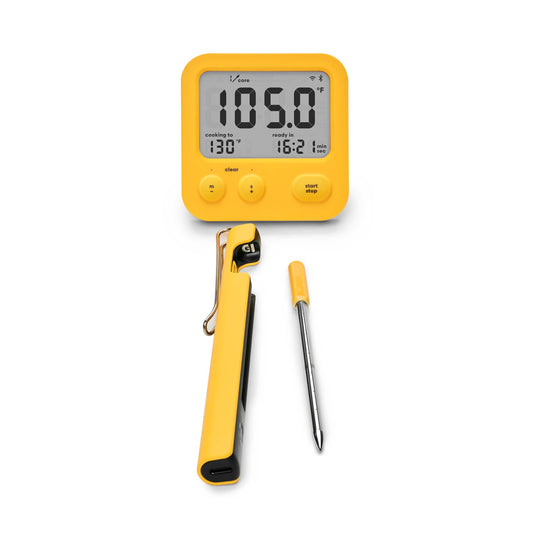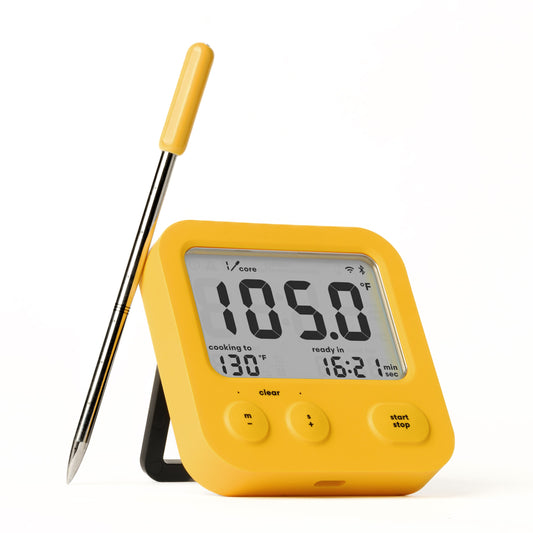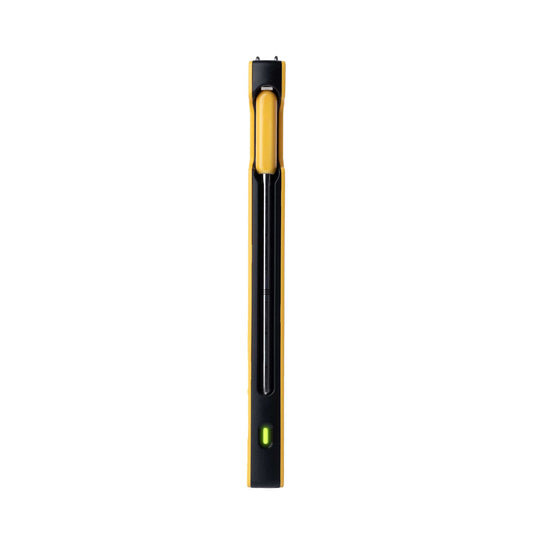It's never just temperature.
Share
**Hi, you're viewing the older version of this feature. For the new one, try SafeCook. It's much easier!**
How the Predictive Thermometer determines if your cook is "USDA Food Safe"
There’s more than one way to kill bacteria with heat.
- You can raise the internal temp to the instant heat-death number - 165ºF (for poultry) .
- Or you can cook at lower temps over a longer period of time.

WHAT?!
Yes. 150ºF for 4.2 min is as effective as reaching 165ºF. Either method kills at least 99.99999% of Salmonella bacteria.*
5 minutes at 150ºF is enough for almost any food (even a fat, juicy turkey!)
And even that is an oversimplification! Because it doesn’t account for the cooking that takes place while your food is coming up to temp or resting.
Chicken cooked like this will be just as safe, but far more tender and juicy. And yes - a bit pink.
So pink chicken is actually safe?
And delicious, if you follow these “alternate” time and temperature-based rules. Which are, by the way, not something we made up – they’re also part of the USDA food safety guidelines. They were incorporated into the 2022 FDA Food Code that most county health departments (in the US) adhere to.
But they’re not usually shown to the public because they’re complex. You’d need a way to reliably track time at temperature to make them practical (hint!).
The “USDA recommended” temperature table is a very (over)simplified version of their scientific guidance.
Commercial food producers and some restaurants use these alternate food safety guidelines of time + temp to make food that is extremely safe and much more delectable than it would be if they followed the famous “posted-on-the-walk-in-freezer” limits.
How do I cook safely without overcooking?
You’re going to need an accurate thermometer. And it sure would be nice if that thermometer was leave-in, wireless and smart, so you could watch the temps and times and take notes.
Plus you’ll need a copy of the 2022 FDA Food Code (and you might want to read the USDA FSIS Cooking Guidelines for Meat and Poultry Products Revised Appendix A too; links down below if you're interested).
That's only about 760 pages of “light” reading.
But what if my thermometer knew the USDA guidelines back-to-front and could just tell me?
Done! The Combustion Predictive Thermometer (CPT) now does exactly that with our NEW “USDA Food Safe” feature.**
And it's included with the freshest firmware and newest Combustion app.
**Note: All home cooking is at your own risk. No warranty or guarantee of safety is implied. Please read the full terms (legal stuff!) at the bottom.
Here’s how it works–
- Simplified mode: The CPT tells you when your food has hit the USDA food safety temp you’re familiar with (165ºF for chicken, for example).
- Integrated mode: The CPT tells you when your food has passed the formal USDA food safety recommendations - by integrating all of the time at safe temperatures (including the time coming up to temp and any resting time). RECOMMENDED!
Math note: in integrated mode, the CPT uses a rolling calculation to determine when your food meets the required level of food safety as set by the USDA. Different foods are held to different standards (measured on a logarithmic scale* - usually 6.5 or 7-log, depending). You don’t have to know any of that because the thermometer knows.
We also keep track of heat-up and cool-down time and let you know if your food has spent too much time in the “danger zone” where bacteria can thrive.***
That’s another layer of safety on top. One less thing to worry about!
HOW TO MAKE IT "USDA FOOD SAFE":
- Select your meat to set the relevant USDA safety standard
- The Predictive Thermometer tells you when you’ve reached USDA recommendations – by way of the alternate USDA safety standard (time-at-temp) or the simplified table.
- If you don’t choose, the CPT will default to “simplified-chicken”, which is the highest standard.
- Set your prediction (as normal)
- When your food reaches the USDA Safety standard (by either method), a notification will appear on the Combustion App.

NO MORE OVERCOOKING “JUST TO BE ON THE SAFE SIDE.”
Honestly, we kinda just re-invented chicken. You can thank us later.
"Before-you-ask" FAQs:
Is this only for chicken? No! It works on pretty much any food. We talk about chicken because poultry is the bad boy of meats, bacteria-wise. And because it's so easy to overcook! Select your protein from the list - whether that's chicken, fish, beef, pork, seafood, or something else. The Combustion Predictive Thermometer (CPT) follows the 2022 FDA Food Safety Code and USDA-FSIS recommendations based on the food you choose.
Is this backwards compatible? Yes. This is another free upgrade for every Predictive Thermometer we’ve ever made. The CPT keeps getting better, even after you’ve bought it - that’s the magic of firmware updates.
Do I have to cook my food to a USDA-level of food safety? No, at least not if you’re cooking in your own home. Thankfully the health department doesn’t have the authority to tell you how to cook in your own home. But a lot of folks overcook their meats out of fear. We wanted to make it easy to cook juicy, delicious food without worrying that it might make you sick.
BTW, in restaurants, if the food is cooked and served immediately, and by request cooked a certain way (e.g. rare steak or eggs sunny-side up) that’s also okay. The restaurant is required to let you know that eating rare or undercooked foods comes at a higher risk - most places put this right on the menu. (In small type, at the bottom.)
What’s up with seafood? The Integrated Standard is higher than the Simplified one? If you’re cooking and eating your seafood (fish, shellfish, etc) immediately, we recommend you use the Simplified standard. It’s a case where the official food safety guidance is targeting Listeria as the pathogen, rather than Salmonella. The result is that the integrated time/temp standard for seafood is actually more challenging to meet than the simplified guidance published by the USDA for the general public.
If you intend to cook and chill your seafood as a ready-to-eat product (cook now, eat later), the more conservative integrated standard is the one to use.
What about non-US people? Food standards vary by country, but they’re all similar because bacteria don’t recognize international borders. While some countries have more conservative standards based on Listeria as the target organism, the US-centric standards still provide a very high level of food safety (we are looking into localization options in the future).
What about commercial use? For commercial use we'll want to have each thermometer certified and traceable against a NIST-standard of accuracy. You'll also likely need more specifics about the target pathogen and standards being applied to keep your health inspector happy. This is coming! It’ll be part of an optional software upgrade that makes record keeping easy for food industry professionals. Everything you need to comply with your local health department or process authority.
NOTES (Science stuff):
*The USDA Food safety recommendations that are incorporated into the FDA 2022 Food Safety Code are mostly designed around killing salmonella bacteria.
It’s not the only bacteria that can make you sick, but it’s the most common in meats (particularly in chicken). And its heat-tolerance overlaps the heat-tolerance of other dangerous organisms. If you kill salmonella, you’ve killed most other bugs (like E. Coli) too.
For some foods the target pathogen is something other than salmonella, such as Listeria monocytogenes or Coxiella burnetii and in those cases we use parameters that target the destruction of those organisms instead.
*For lean chicken (like breast), the time is even shorter (2.8min at 150ºF). For higher fat chicken or turkey, the time/temp combo is a bit longer but not much - 5 minutes at 150ºF more than covers each of those (I told you it was a simplification).
- The log scale works like this: each 0.9 is one log. Log-7 means a 99.99999% kill-through rate.
*** About the "Danger Zone": this is the temperature range where bacteria multiplies. Consumers are often told it's 41 - 140°F, while the codified guidance is 41-135ºF. Even then there's quite a bit of nuance to when and how this should be calculated and applied.
As long as meat comes up to to 130 °F in 6 hours, you're out of the "danger zone." That's why some meats can be safely cooked low-and-slow at 130°F.
When cooling, the danger zone starts at 135°F and foods need to cool below 41°F within 6 hours. We keep track of all these rules too.
****The integrated method used here (and by commercial food preparers) is a pasteurization process, which is similar to canning (but not the same). Canned goods are heated to time-at-temp to become functionally sterile, which is why they can be stored at room temperature. The pathogen of concern is different (usually C. botulinum for not acidic foods) and the level of destruction is much higher (typically Log-12). The required process we describe doesn’t go quite that far, but it’s the same principle.
DISCLAIMER (legal stuff):
**All home cooking is at your own risk. Combustion has used reasonable effort to ensure that the "USDA Food Safe" feature is accurate and follows the guidance contained in the 2022 FDA Food Safety Code and USDA FSIS Cooking Guidelines for Meat and Poultry Products Revised Appendix A. However, Combustion LLC does not give any express or implied warranty as to the accuracy, correctness, and completeness of the information provided by this feature, that it is free of bugs or defects, that it will guarantee food is safe for consumption and will not cause food borne illness, or that this feature will be suitable for any purposes other than to provide general consumer education about factors the contribute to food safety.
P.S. Want to do the math yourself? Go nuts!
USDA FSIS Cooking Guidelines for Meat and Poultry Products Revised Appendix A


